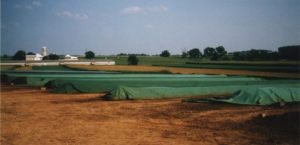Why Use Windrow Covers?
 |
Increased Control:
In the ACS compost production process, windrows are covered to prevent heavy rains from damaging the compost |
 |
Cover your windrows to better control the composting process:
Rain falling on uncovered windrows is absorbed into the row opening the potential that windrow materials could |
 |
Rain falling on windrows covered with a special gas-permeable, water shedding fabric is not allowed to be absorbed into the row. Rain water runs off the cover and onto the ground between the rows. The clean rain water is then absorbed by the ground. |
 |
Covering your windrows:
Lay the windrow cover out over the windrow length-wise. |
 |
Covering your windrows:
Throw weights attached to rope across the width of the windrow every few feet. The weights/ropes combination |
 |
If the climate is wet, excess moisture is kept out of the windrow; if the climate is dry, moisture is retained within the row. While shedding rain, gaseous exchange is still permitted. Nutrient retention is higher, the compost cycle will finish sooner, and ultraviolet ray damage is minimized.Covered compost retains temperature levels better than uncovered. In freezing conditions, covered compost does not freeze as deeply during winter and warms faster in spring.Leaching is significantly reduced when compost is covered.If you need additional information about this or any other part of the composting process, feel free to contact us. |
